










Sheaffer PFM: The Pen For Men 1959-1968
by Jim
Mamoulides, February 8, 2002

1959 - The Pen For Men Is Launched
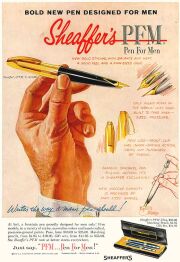
1959 PFM Advertisement Featuring the PFM V
By 1959, Sheaffer was leading the market in pen sales with its successful Snorkel pens. The 1950s saw Sheaffer and others move away from the larger and fatter pens of the decades before to long and slender pens, such as the TM or Thin Model pens. The PFM was a bold step in a new direction.
The PFM, Sheaffer's largest Snorkel model, was introduced at a price range of US $10 for the all plastic and stainless trimmed PFM I to US $25 for the gold filled cap and trim PFM V model. Matching pen and pencil sets were US $14.95 to US $35.00. Many collectors prize this pen and they command high prices, compared to other pens from this period. Like another now highly collectible pen, the Parker Duofold Mandarin, the PFM was not a great success, with the line being pared of models later in the production run. According to research done by Sam Marshall, the PFM full line ran until 1963, with only the PFM III and V listed later, and the line was finally discontinued by 1968. The PFM was run parallel with the very similar and smaller the Lifetime (soon to be Imperial), introduced in 1963.
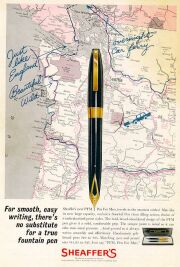
1960 PFM Advertisement Featuring the PFM III
The PFM is a classic design that, like other landmark pens, captures the design influences of the times. Sheaffer reintroduced this classic design in the current all-metal Legacy line in the 1990s. The Legacy, however, is a Touchdown pen. Sheaffer has not made a Snorkel pen since production ceased with the TM and PFM pens.
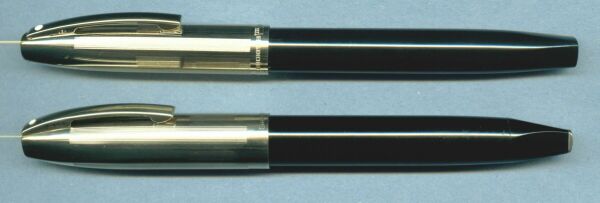

Sheaffer
Imperial Deluxe Modern (Top) / PFM V c1959 (Bottom) -
Both Gold / Black
The PFM came in five principal models, varying by cap and trim color:
PFM I -
Single color plastic cap and barrel, polished stainless
steel clip and cap band, and palladium silver nib. The
PFM I is the only model without the White Dot.
PFM II - Frosted stainless steel cap and
plastic barrel, polished stainless steel clip and cap
band, and palladium silver nib.
PFM III - Single color plastic cap and
barrel, gold filled clip and cap band, and 14kt gold nib.
PFM IV - Stainless steel cap and plastic
barrel, gold filled clip and plunger cap end plate, and
14kt gold nib.
PFM V - Gold plated cap and plastic
barrel, gold filled clip and plunger cap end plate, and
14kt gold nib.
In addition, Sheaffer made a variant of the PFM III called the Autograph, following in the decades tradition of producing pens with 14 karat gold cap bands suitable for engraving. Autographs are very uncommon and command a significantly higher price than the PFM III.
Autograph - Black plastic cap and barrel, gold filled clip and plunger cap end plate, and 14 karat gold cap band, and 14kt gold nib.
As with the Thin Model Snorkel line, Sheaffer made demonstrators similar to the PFM III to show the inner workings of the complex Snorkel filling system. Demonstrators are rare and sell at a premium.
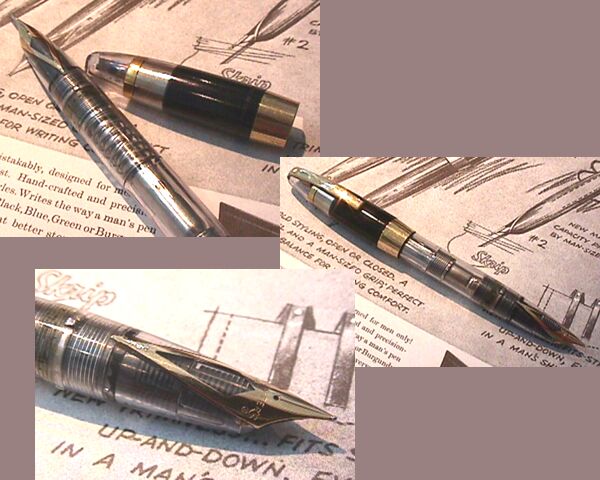
Sheaffer PFM
Demonstrator - Photos Courtesy of Tim Barker
Demonstrator - Clear and black plastic cap and clear barrel, gold filled clip and cap band, and 14kt gold nib.


Sheaffer PFM I
c1960 Green - Note that the pen has no White Dot
The pen was produced in five colors: black, blue, burgundy, green, and gray. The rarest colors are gray, blue and green. On the all plastic pens, the cap lip has a pronounced taper, where on the metal cap pens, the cap lip is straight. The cap band is much wider that on similar Imperials, which further emphasizes the taper.
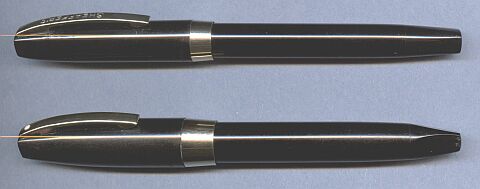

Sheaffer Imperial Touchdown c1965 (Top) / PFM III c1960 (Bottom)
- Both Black With Gold Filled Trim
Compared to a modern Imperial, the PFM is a large pen. I picked a gold cap Imperial to emphasize the contrast between the PFM and its immediate successor.

Sheaffer PFM V
Gold / Black Showing Open Touchdown Filling System
Like the TM pens that preceded it, the PFM uses a Snorkel mechanism to fill with ink. The Snorkel extends when the plunger cap is twisted to release the Touchdown sleeve. One quick downstroke with the Snorkel tip dipped in ink is all that is needed to quickly fill the pen. The Snorkel tube extends quite far past the end of the nib, even more so than on the TM pens, so filling requires no wiping.
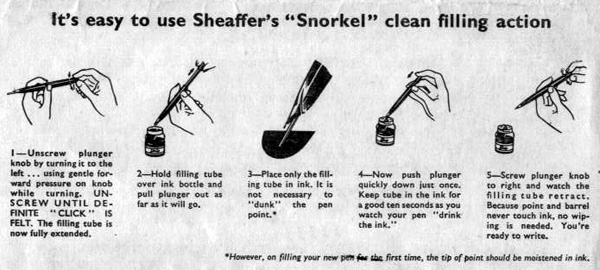
Sheaffer PFM
Filling Instructions
PFM Features
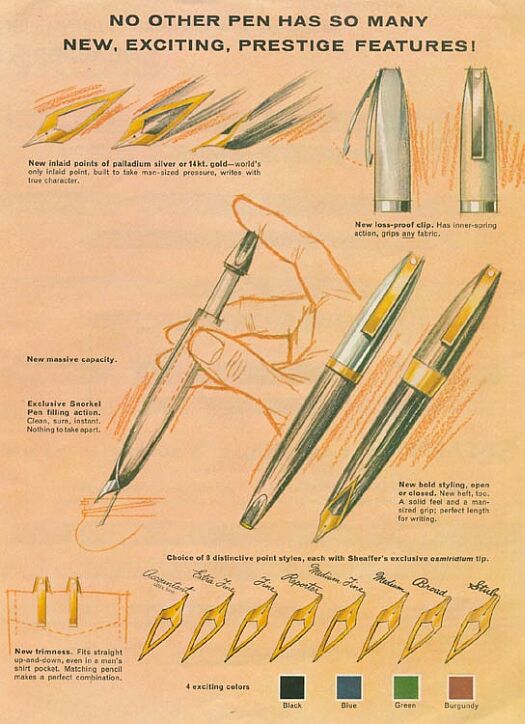
Sheaffer 1959 PFM Advertising Detail Showing Key PFM
Features and the PFM III and IV
Although the first advertisements for the new PFM loudly proclaimed a myriad of new features for the pen, the really big news was the inlaid nib. No other pen had anything like it. It was a bold statement in a new direction from the current choices of open or hooded nibs. The inlaid nib allowed Sheaffer to continue a streamlined look to the pen and give it open nib character at the same time.
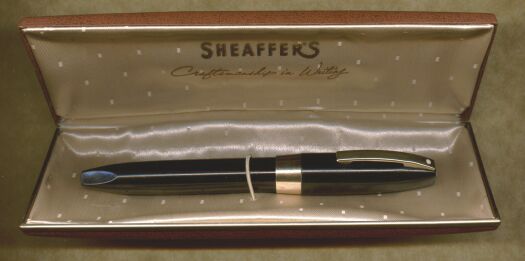
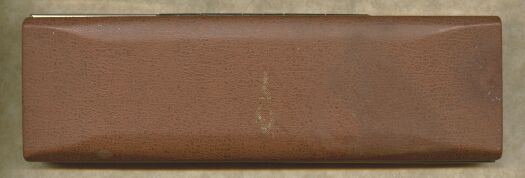
Sheaffer c1960
PFM III in Single Pen Case - Note Inlaid Nib Logo on Top
The rest of the features were more evolutionary. The pen retained the spring clip Sheaffer introduced on Triumph pens in the 1940s with a new (and bigger) squared off design, giving the pen more grip in the pocket. And though the pen was still a Snorkel, the larger pen body made room for a bigger bladder, allowing the pen more ink capacity.
A feature not mentioned in the detail above is the three peg friction fit for the cap. For years Sheaffer advertised improvements in screw on caps, so the PFM was a real departure from the traditional Sheaffer pen. Inside the cap there is a ridge that snaps onto the three pegs on the section. This method is used on the Imperial and the Legacy today.
A Bold New Nib
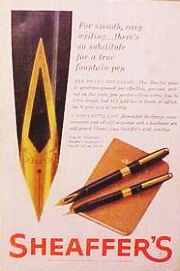
1961 PFM Advertisement Showing the Inlaid Nib on the PFM
III
The new inlaid nib was so distinctive that it became a Sheaffer hallmark. Sheaffer to this day strongly presents the unique nib in its advertising. After the PFM, the nib moved to the Imperial, then the Targa, then the Legacy and now the Intrigue. Like the Triumph nib before it, Sheaffer made the nib, which is the focus of the pen, speak loudly of its maker.
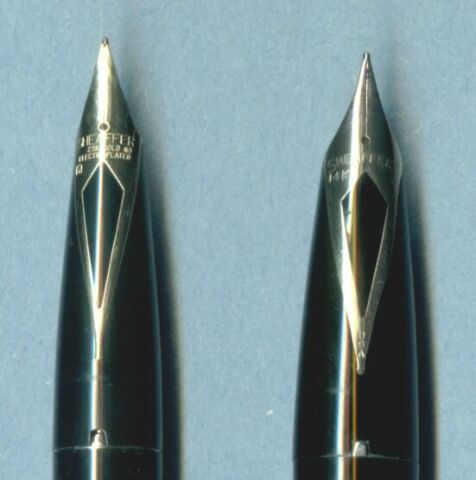
Detail Showing
Nibs - Imperial Deluxe Modern (Left) / PFM V c1959 (Right)
The nib maintains its proportions in the Imperial and clearly in the modern Deluxe model, as with the earliest Lifetime Imperials, the intent was to closely mimic the PFM nib, as can bee seen in these details.
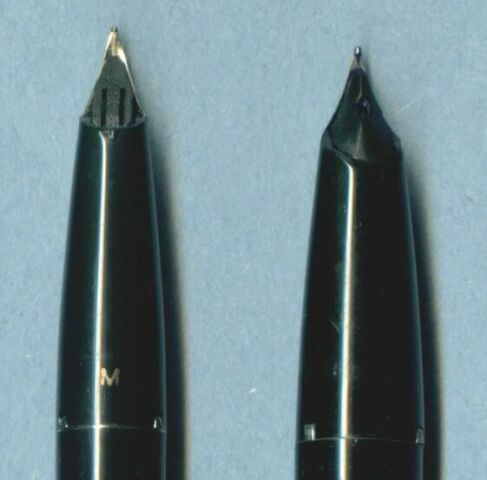
Detail Showing Underside of Nibs - Imperial Deluxe Modern
(Left) / PFM V c1959 (Right)
The section of the Imperial follows every detail of the PFM closely. Note the Snorkel opening in the PFM feed.
Performance
I thought it would be fun to chose a gold cap and black Imperial as a comparison pen to the PFM, as the Imperial, in my opinion, draws more closely its design from the PFM than the Legacy does. My reason is that Imperials can be found in the same cap and body configurations as the PFM, save the Snorkel, where the Legacy, being an all metal pen, has the PFM size, but is heavier and colder than the plastic body PFM. And, frankly, the PFM / Legacy comparison has been done recently elsewhere.
I wish I had a Touchdown Imperial with a gold filled cap, but that will have to wait.

A Collection
of Sheaffer PFM Pens
Both the PFM and the Imperial I tried have medium nibs. The PFM is a bigger and heavier pen, but interestingly, not heavier by much when the Imperial uses its converter. Both pens are virtually identical in length, 5 3/8 inches long capped and 5 3/4 inches posted.
Both pens are well finished, and have a lot of visual similarity to the eye and hand. Noted differences are the clip on the PFM is closer to flush with the cap top, the gold plate on the plunger cap, and the length of the engraved shorter line sets on the PFM cap are shorter by half. It's clear the Imperial Deluxe is a modern design successor to the PFM V.
The Snorkel on the PFM is efficient and fills quickly on two downstrokes - no fuss, where the squeeze converter in the Imperial pen is simple and straightforward, but you have to wipe the nib.
Both pens have the inlaid nibs, but the PFM is 14kt where the Imperial is electroplated, and both write quite smoothly with nice wet lines with no variance. Neither nib is overly stiff, but there is no flex. The PFM really feels good in the hand and is fun to write with. The PFM also has a nice cachet. This one has been at the office and passes the notice test and the daily user test.
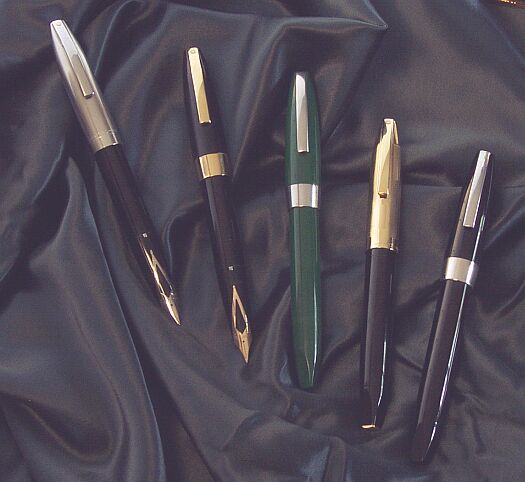
A Collection
of Sheaffer PFM Pens: II / III / I / V / I
Both of these pens would look good in a starched pocket under a suit coat, but the Imperial is a pretender next to the PFM, a pen that lives in the boardroom, where the Imperial visits when called. A restored PFM would definitely fit the bill as a great pen for the office in every way, including ease of use, great writing, and strong and independent statement.
Acknowledgement
Thanks to Daniel Kirchheimer and Sam Marshall for additional information on the PFM models. Thanks to Tim Barker for his photographs of the PFM Demonstrator.
Comments on this article may be sent
to the author, Jim Mamoulides
PenHero.com Bibliography